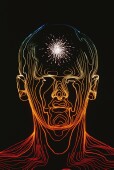
TUESDAY, March 5 (HealthDay News) — The key to correctly diagnosing when a case of dizziness is just vertigo or a life-threatening stroke may be surprisingly simple: a pair of goggles that measures eye movement at the bedside in as little as one minute, a new study contends.
“This is the first study demonstrating that we can accurately discriminate strokes and non-strokes using this device,” said Dr. David Newman-Toker, lead author of a paper on the technique that is published in the April issue of the journal Stroke.
Some 100,000 strokes are misdiagnosed as something else each year in the United States, resulting in 20,000 to 30,000 deaths or severe physical and speech impairments, the researchers said.
As with heart attacks, the key to treating stroke and potentially saving a person’s life is speed. Magnetic resonance imaging (MRI), the current gold standard for assessing stroke, can take up to six hours to complete and costs $1,200, said Newman-Toker, who is an associate professor of neurology and otolaryngology at Johns Hopkins Hospital in Baltimore.
Sometimes people don’t even get as far as an MRI, and may be sent home with a first “mini stroke” that is followed by a devastating second stroke, he added.
The new study findings come with some significant caveats, however.
For one thing, the study was a small one, involving only 12 patients.
“It is impossible for a small study to prove 100 percent accuracy,” said Dr. Daniel Labovitz, director of the Stern Stroke Center at Montefiore Medical Center in New York City, who was not involved with the study. About 4 percent of dizziness cases in the emergency room are caused by stroke.
The other caveat is that the device is not yet approved in the United States for diagnosing stroke. The U.S. Food and Drug Administration only recently gave it approval for use in assessing balance. It has been available in Europe for that purpose for about a year.
The device — known as a video-oculography machine — is a modification of a “head impulse test,” which is used regularly for people with chronic dizziness and other inner ear-balance disorders.
“There are 500 otolaryngologists and 4 million dizzy patients in the U.S. alone,” Newman-Toker said. “We [otolaryngologists] can’t see everybody and [emergency room physicians] can’t easily be trained to develop expertise in eye movement interpretation.”
“Now we have a device that can do it for them,” he added.
The test is simple to perform: Wearing a pair of goggles hooked up to a webcam and special software, the patient is asked to focus on one spot on the wall while the doctor moves the patient’s head from side to side.
“Normally, the balance system in the ears keeps our eyes stable when our head is moving,” Newman-Toker explained.
For people with vertigo, the test is “almost always abnormal,” he said. But stroke patients, even though they have the same dizzy symptoms, don’t have this impairment.
In this small, “proof-of-concept” study, the test was 100 percent accurate when compared with MRI, sorting out six people with strokes and six without, the researchers said.
Newman-Toker believes the test could one day be incorporated into a smartphone application.
Labovitz said the device could be a “game changer” if its value is confirmed in larger studies. “This is such an important area where we struggle all the time,” he said.
GN Otometrics, which makes the device, loaned the devices for the study, but the research was funded by the U.S. National Institutes of Health and other Swiss and U.S. health organizations.
More information
The U.S. National Library of Medicine has more on stroke.

